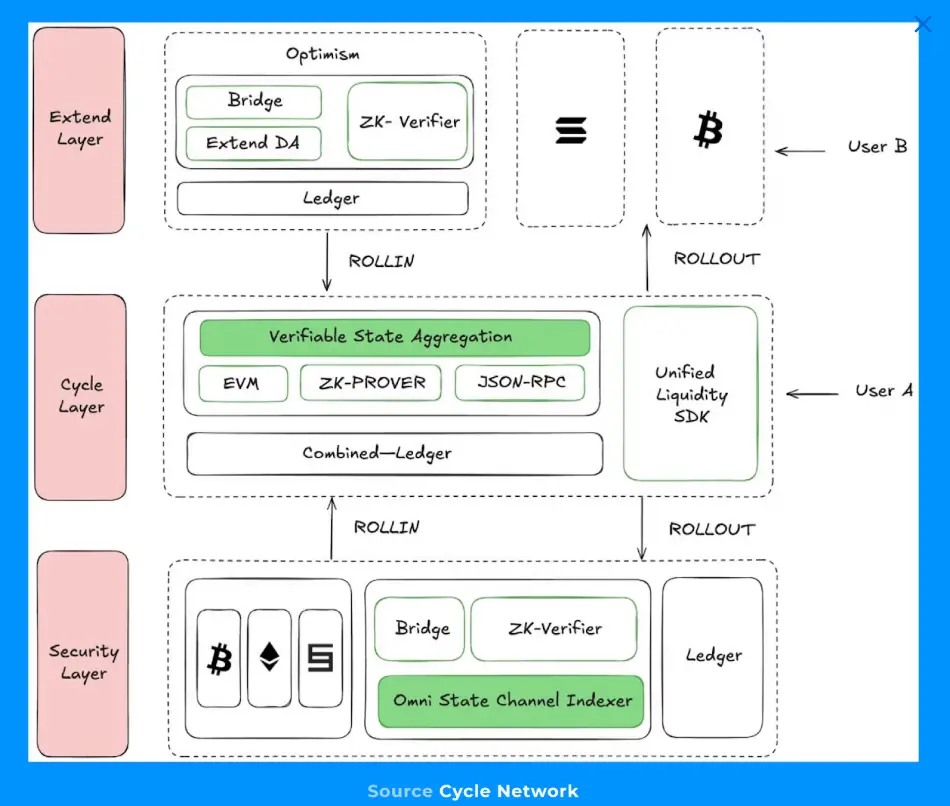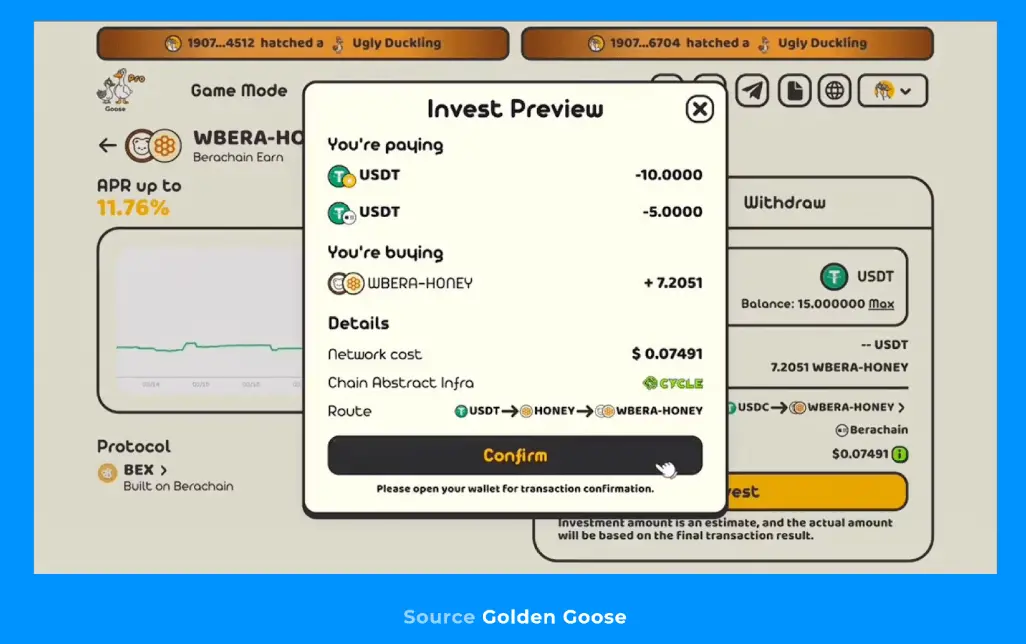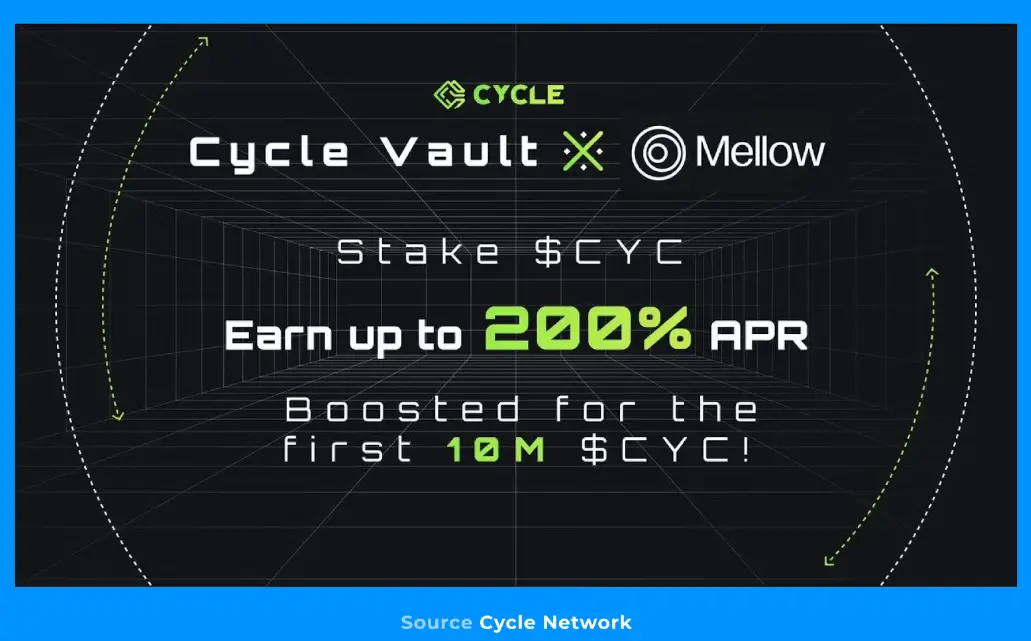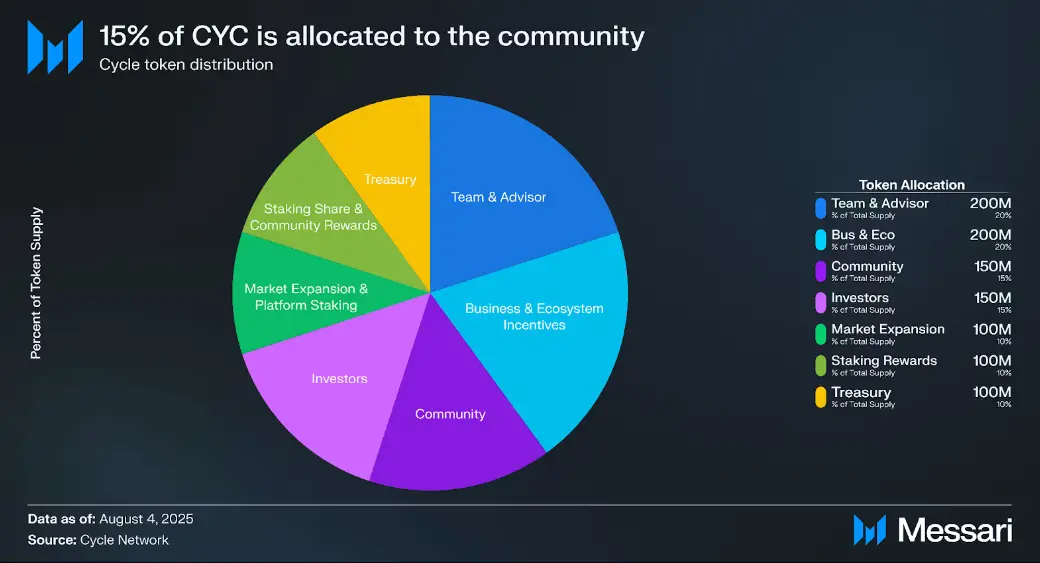Key Points:
- Cycle Network adopts a three-layer architecture design: using Ethereum as a security anchor to achieve cross-source network connection expansion, and integrating transaction activities through zkEVM rollup, thereby eliminating reliance on traditional cross-chain bridges.
- This infrastructure has supported practical applications such as full-chain stablecoin settlement and chain-abstracted GameFi. Projects like Golden Goose demonstrate how Cycle simplifies operational complexity while providing yield strategies.
- Since the launch of the Alpha mainnet, Cycle has secured over $400 million in assets and processed over 2.7 million transactions.
- The issuance of the CYC token aims to reward early users, promote ecosystem development, and maintain network security. Of this, 20% is allocated for community airdrops, and 10% is used for staking security mechanisms, with its tokenomics designed to achieve long-term participation and decentralization.
Introduction
Cycle Network is building a multi-chain settlement layer that simplifies the complexity of multi-chain environments without relying on cross-chain bridges. This infrastructure has secured over $400 million in assets, processed over 3 million transactions on the mainnet, and integrated more than 20 networks, including Monad, Berachain, Sonic Labs, BSC, and Base.
Its architecture consists of three layers: the security layer ensures state integrity through Ethereum and zero-knowledge proofs (ZKP); the expansion layer connects all source and target networks through decentralized endpoints and expanded data availability (EDA); the Cycle layer acts as a zkEVM rollup aggregating cross-network activities. These three layers work together to maintain global state synchronization, allowing applications and users to operate as if on a single network.
This infrastructure supports practical applications such as full-chain stablecoin settlement and simplified multi-chain interfaces, enabling bilateral reconciliation with traditional banks regarding real-world assets (RWA) and stablecoins, enhancing transaction verifiability and transparency.
Cycle Network Overview
The technical architecture of Cycle Network aims to integrate multi-chain networks into a unified bridge-less settlement layer through three core components: the security layer, the expansion layer, and the Cycle layer.

The security layer is the cornerstone of Cycle Network's integrity and security. This layer relies on Ethereum's decentralized programmable infrastructure, anchoring the global state on Ethereum, thereby inheriting its robust security guarantees. By combining Ethereum endpoints with zero-knowledge proof (ZKP) technology, Cycle achieves trustless on-chain verification of network activities. These ZKP proofs submitted to Ethereum allow anyone to independently verify Cycle's state updates, thus inheriting the security of Ethereum's consensus mechanism.
The expansion layer encompasses all source and target networks that store transaction data, including Layer 1, Layer 2, and dedicated application chains. Cycle deploys endpoints (Endpoints) at each expansion layer, ensuring complete message retrieval through the expanded data availability (EDA) mechanism. These endpoints achieve cross-network state synchronization through decentralized indexing.
The core Cycle layer serves as an advanced rollup layer, aggregating transactions from the security layer and expansion layer. It employs decentralized sequencers and zkEVM provers to maintain a consistent global state across diverse networks. This architecture allows users to securely interact across multiple chains without manually crossing chains or adapting to specific interfaces.
Stablecoin Liquidity and Multi-Chain Settlement
Cycle Network enables seamless circulation of stablecoins across different networks, akin to flowing within a single system, significantly enhancing liquidity and settlement efficiency between chains. Its multi-chain settlement capability fundamentally transforms the reconciliation, verification, and confirmation mechanisms of stablecoins across chains, allowing users to access unified liquidity without complex cross-chain operations.
For stablecoin issuers, Cycle provides verifiable proofs to ensure that on-chain token activities fully match off-chain bank reserves or real-world assets. By aggregating all transactions into an auditable ledger, every token flow between integrated networks can be transparently recorded and verified. This architecture meets compliance requirements while enhancing trust from regulators and the market through asset anchoring mechanisms.
Developers also benefit from a simplified multi-chain deployment process. In traditional models, contracts need to be deployed separately on each network, while the Cycle SDK supports one-click full network synchronized deployment, significantly shortening development cycles and accelerating time to market, with convenience comparable to the virtualization revolution of cloud infrastructure for deployment environments.
Golden Goose: A Practical Case of Chain-Abstracted GameFi
Golden Goose is a GameFi platform built on Cycle Network that simplifies multi-chain strategies into a gamified experience. Users can "hatch" virtual geese by staking assets like USDT, earning VEGOOSE token rewards and CYC token airdrops by completing yield tasks. The platform's underlying infrastructure, powered by Cycle, enables automatic cross-chain operations, exchanges, gas payments, liquidity provision, and staking functions, allowing users to simply select strategies and click "stake" through a unified dashboard, with the system managing multi-chain asset scheduling via Rollin/Rollout infrastructure and a unified liquidity system.

Golden Goose significantly lowers the entry barrier for both crypto-native and mainstream users. Players can start earning rewards by logging in with a social account, without needing to set up a wallet. The application’s marketing campaign has attracted over 800,000 addresses, including 100,000 users from TikTok. As of August 2025, the mainnet has attracted 20,000 paid addresses, with a total locked value of $15 million, performing particularly well in markets such as Latin America, Brazil, Japan, and Turkey.
Cycle Network Token Issuance
The Alpha mainnet of Cycle Network officially launched on February 10, 2025, marking the start of the pre-token generation event (pre-TGE) phase. Alongside the mainnet launch, incentive measures such as testnet rewards, developer bounty programs, and early user competitions were introduced to promote network activity.
An important milestone in the pre-TGE phase is the launch of the Cycle Liquidity Hub in mid-June 2025. As a core infrastructure before token generation, this hub essentially serves as Cycle's multi-chain stablecoin and asset clearing center. Users depositing assets will form a cross-network liquidity reserve pool for Rollin/Rollout processes. Participants not only earn transaction fee revenue but also qualify for token rewards. The launch of the liquidity hub simultaneously initiated a series of airdrop plans aimed at rewarding network supporters during this phase.
Airdrop Mechanism and Participation
Cycle Network has reserved 20% of the total token supply as a community airdrop reward pool, specifically to incentivize early supporters (such as liquidity providers and active users). This airdrop plan adopts an inclusive design principle, setting a maximum contribution value of approximately $1,000 per individual address, effectively preventing whale monopolization of allocation quotas through a contribution cap mechanism. Excessive recharges or multi-wallet strategies cannot significantly increase airdrop points, ensuring fairness in the leaderboard.
To enhance participant rewards, the platform simultaneously launched the Mellow CYC staking yield enhancement program, allowing users to stake CYC for up to 200% annualized returns. This mechanism continuously incentivizes community members to participate in ecosystem building during the airdrop reward waiting period.

Token Economic Model
Cycle Network's token economic model employs a fixed supply of CYC tokens as the network utility and governance token, with a total supply of 1 billion tokens and no further issuance. CYC distribution covers multiple categories, aiming to simultaneously promote project development and community incentives:

- Team and Advisors (20%): Token distribution has a 12-month lock-up period (no release in the first year post-TGE), followed by linear unlocking over 48 months.
- Business and Ecosystem Incentives (20%): This portion of tokens serves as a special fund for ecosystem development, initially distributed based on quantifiable contributions (e.g., rewarding projects that bring traffic to Cycle or funding network infrastructure development teams). Once on-chain governance is initiated, the community will vote to determine specific allocation plans.
- Community Incentives (15%): Specifically for community programs (including airdrops and user incentive measures implemented before TGE, as well as ongoing reward mechanisms post-TGE), distributed biannually and fully released within three years.
- Investor Shares (15%): For early investors and strategic partners (including incubation funds), with a 1-year lock-up period, followed by gradual unlocking over 24 to 36 months based on agreement terms.
- Treasury Reserves (10%): Locked for 6 months post-TGE, then gradually released over 48 months.
- Market Expansion and Platform Staking (10%): This portion of tokens is used for market expansion, ecosystem growth, and staking incentives. Some may be activated at TGE (e.g., initial liquidity or exchange listings), while the remainder will be used for growth plans and liquidity enhancement based on development needs.
- Staking and Shared Security Rewards (10%): Specifically for incentivizing participants who maintain network security through staking (including Symbiotic re-staking and Cycle native validator staking). Tokens will be distributed as rewards to stakers who provide security for Cycle Network and its multi-chain transactions, with a long-term linear unlocking period set at 60 months (5 years). This slow release mechanism ensures continuous incentives for security maintainers and aligns with Symbiotic's re-staking model—stakers provide security for multiple networks (including Cycle) through long-term asset locking and earn rewards.
CYC Token Functions and Incentive Mechanisms
The CYC token has multiple functions within the Cycle Network ecosystem, with its demand directly linked to network usage. Core functions and incentive roles include:
- SDK Usage Fee: Developers building applications on Cycle must pay CYC as a service fee when using the multi-chain API (such as calling Rollin/Rollout functions).
- Network Gas Fee: CYC is the native fuel token for all transactions and smart contract executions within Cycle Network.
- Security Staking (Symbiotic Re-staking): As members of the Symbiotic shared security protocol, CYC holders can participate in staking to maintain network validation security (such as aggregating sequencer nodes). Stakers earn rewards from a 10% staking reward pool. New networks connecting to the Cycle liquidity layer must also stake CYC (for example, Layer 1 connections require locking a certain amount of tokens), and stakers simultaneously gain future governance rights.
- Liquidity Mining Incentives: To launch multi-chain liquidity pools, Cycle rewards liquidity providers with CYC. Users depositing mainstream assets like ETH into the liquidity hub or full-chain liquidity pools will earn CYC rewards. The innovation of this model lies in the fact that, unlike traditional single-chain AMMs, liquidity providers support a multi-chain liquidity system that empowers the entire ecosystem. CYC rewards are used to compensate for impermanent loss and opportunity costs, thereby attracting more funds.
In addition to the core functions mentioned above, CYC will also serve as the governance token for Cycle Network. Although governance features will be launched soon, token holders will ultimately be able to vote on proposals related to protocol upgrades, parameter adjustments, and allocations for specific token pools (such as ecosystem incentives or treasury reserves). This not only grants CYC holders decision-making power over network development but also aligns with the project's decentralization philosophy.
Conclusion
Cycle Network has built a multi-chain settlement infrastructure with unified liquidity, supporting practical applications such as stablecoin settlement. This architecture currently secures over $400 million in assets and processes millions of transactions. Platforms like Golden Goose validate that its infrastructure can support user-friendly multi-chain applications while shielding developers and users from technical complexities.
Post-TGE, Cycle is shifting from infrastructure development to ecosystem expansion. Initiatives like the liquidity hub and airdrop plans before TGE aim to achieve distributed ownership allocation and initiate network participation. The CYC token will serve as a universally functional asset across the network, used for paying transaction fees, obtaining liquidity rewards, participating in security staking, and governance. Through a structured token economic model and clear allocation incentive strategies, Cycle lays the foundation for long-term project development, aiming to become the foundational layer in the fields of multi-chain settlement and unified liquidity.
免责声明:本文章仅代表作者个人观点,不代表本平台的立场和观点。本文章仅供信息分享,不构成对任何人的任何投资建议。用户与作者之间的任何争议,与本平台无关。如网页中刊载的文章或图片涉及侵权,请提供相关的权利证明和身份证明发送邮件到support@aicoin.com,本平台相关工作人员将会进行核查。



